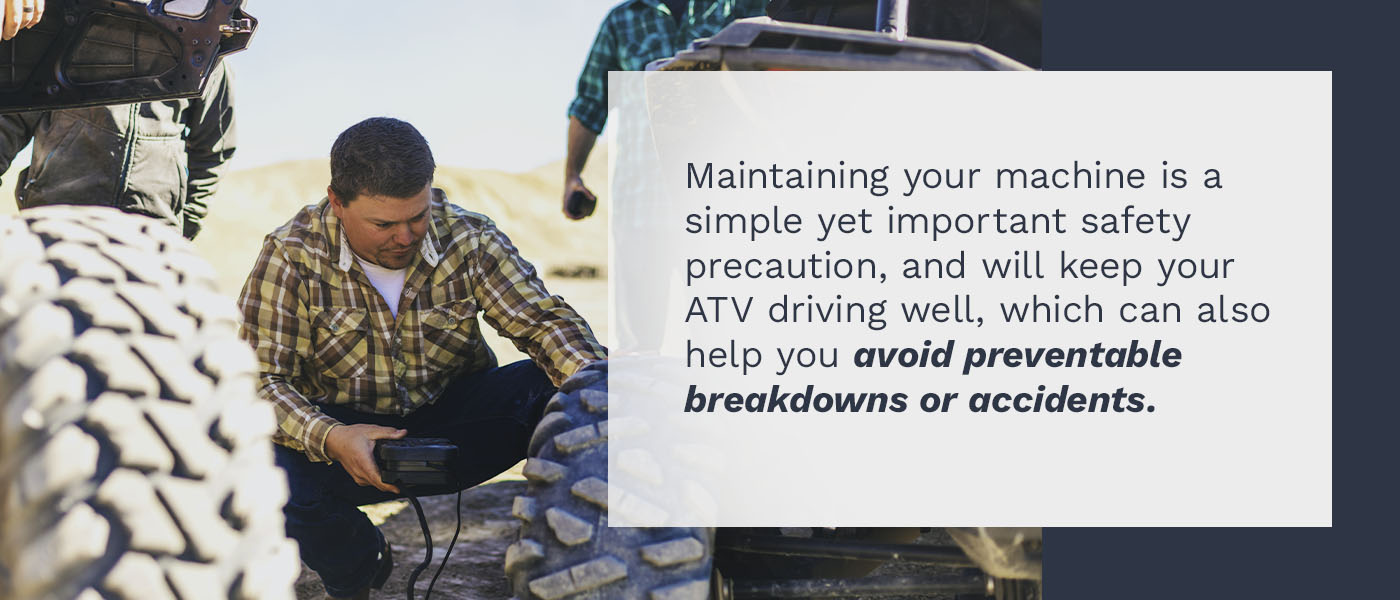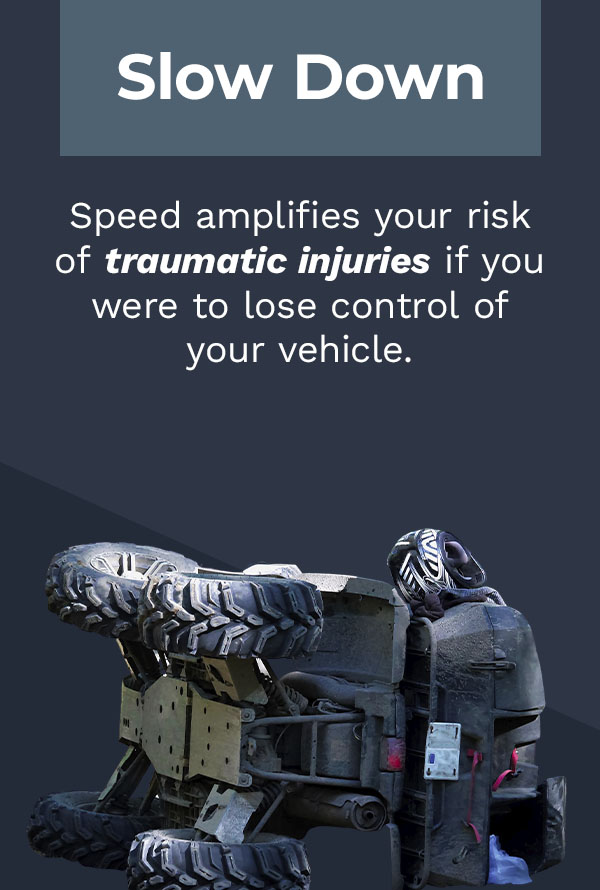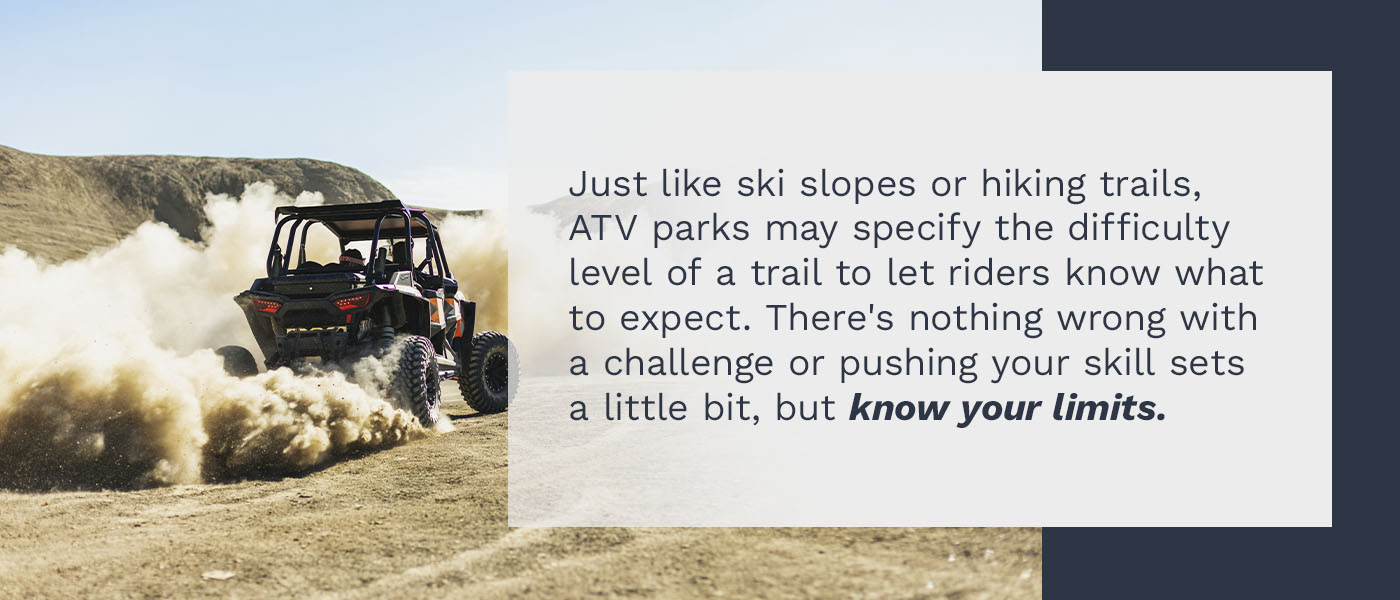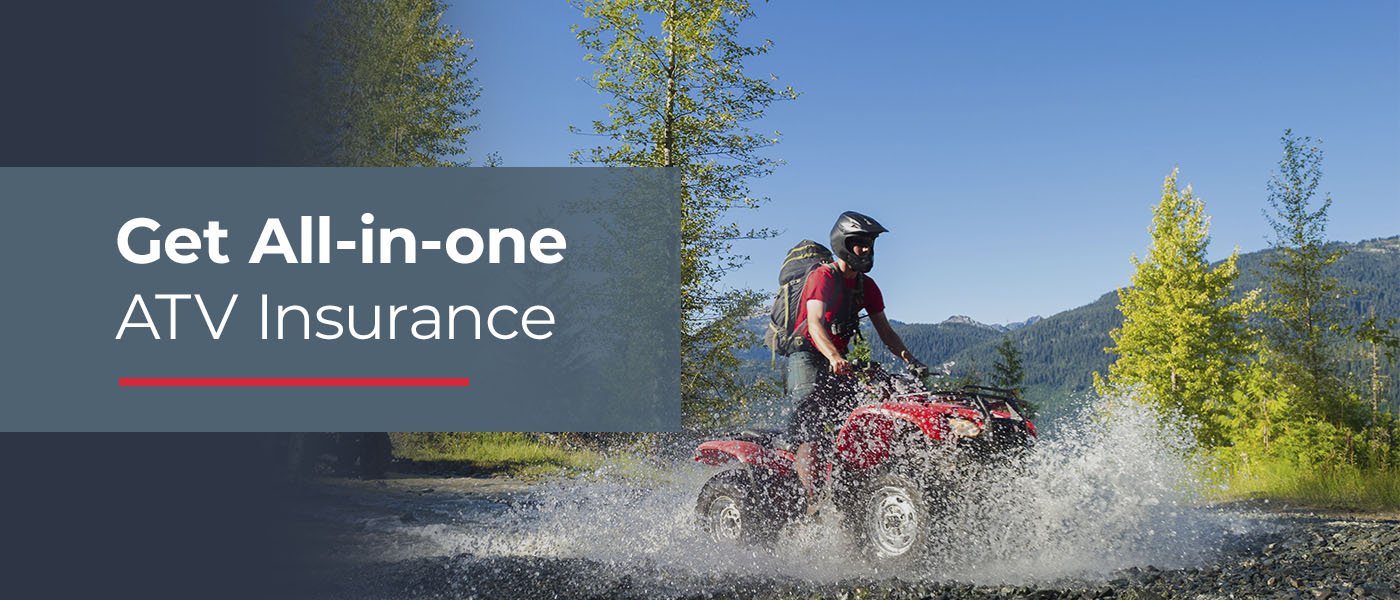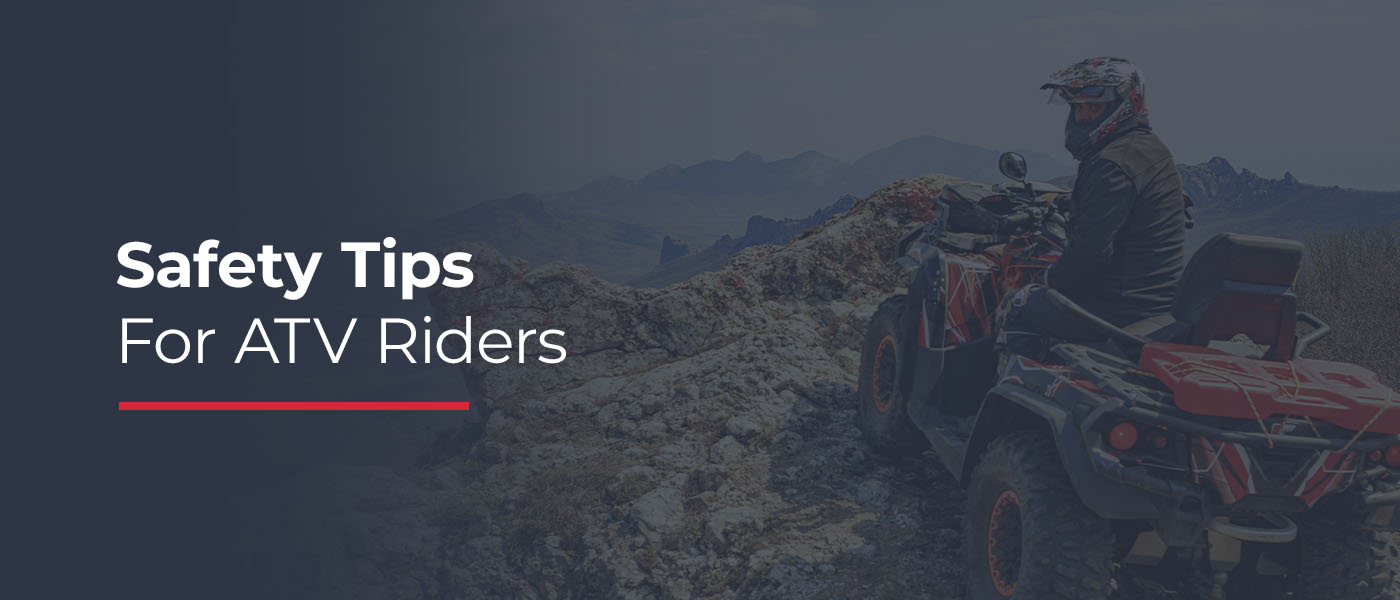
Safety Tips For ATV Riders
Riding ATVs is exhilarating. These powerful vehicles can take you to incredible places and offer thrilling experiences. But just because they’re fun does not mean they are toys. Riding is risky and should be taken seriously. ATV accidents are responsible for 650 deaths and 100,000 injuries in a year. The common causes of ATV accidents include reckless driving, poor preparation and disregarding safety precautions or driving laws. We’ve compiled these ATV safety tips to teach you how to prevent ATV accidents and how to enjoy this incredible sport the right way!
Wear a Helmet and Protective Gear
Your body is very exposed on an all-terrain vehicle, so it’s important that you protect it with adequate gear. It’s not enough to just wear a bicycle helmet, either. You need to wear a helmet approved by the Department of Transportation (DOT) or the Snell Memorial Foundation, which are designed to prevent the sort of head trauma that’s possible in an ATV accident.
But you need to do more than just protect your head. According to Consumer Product Safety Commission’s 2020 report on ATV-related fatalities and injuries, the most affected body parts in accidents were primarily the arm (shoulders to fingertips, 29 percent); the head or neck (29 percent); the leg (21 percent); and the torso (20 percent). So, if you’re riding an ATV, then you should also be wearing:
- Eye protection, such as goggles
- Gloves
- Long sleeves
- Long pants
- Ankle-high boots
Don’t go riding underdressed. In many places, it’s the law to wear a proper helmet, so invest in the right gear and keep yourself compliant and safe!
Maintain Your Machine
Maintaining your machine is a simple yet important safety precaution. Not only will it keep your ATV driving well, it can also help you avoid preventable breakdowns or accidents. Before you ride, look over your ATV and inspect it for any obvious issues. Double check your oil and gasoline levels and make sure there aren’t any leaks. Check the tire pressure, test the brakes and tighten all axle and wheel nuts — there should be no slip when you rock the wheel. Inspect other nuts and bolts to ensure that none have loosened from previous trips or rough terrain. It’s also a good idea to schedule some in-depth maintenance from time to time, such as checking your chain or driveshaft or inspecting the throttle and other cables.
Stay Off Paved Roads
Did you know that 60 percent of ATV deaths were due to roadway crashes? Studies show that all-terrain vehicles aren’t meant for paved surfaces and will handle differently, increasing your risk of collision. But it’s not just the pavement itself — 42 percent of those roadway deaths were on unpaved roads.They’re are also risky due to collisions. Getting hit by a car is catastrophic, even with protective gear and a helmet. Unless you’re carefully crossing a roadway to get to a designated trail, stay off all roads when you’re riding an ATV.
Ride Sober
This one should be obvious, but drinking and driving is all too common on ATVs. In the same way that it’s dangerous to operate a car under the influence of alcohol or drugs, it’s also unsafe to operate an ATV while intoxicated. Impaired judgement and slow reflexes are the last things you want when handling an all-terrain vehicle. Save that drink with your buddies for after you’re finished riding.
Ride Solo on Single-rider Machines
It may be tempting to invite someone to hop on the back of your ATV, but taking another person for a ride could turn dangerous very quickly. It may seem like there’s room for your friend to hop on the back, but a passenger alters the balance of the vehicle, making it easier for them to fall off or for the driver to lose control.
When there are two riders on a single-rider ATV, the most secure place for the passenger to hold onto is going to be the driver, which means that they could pull you off if they lose their balance or tip the vehicle if you stay connected with the handlebars as they’re falling. There’s a reason the vehicle was designed for a single rider, and that’s exactly how it should be ridden. With that said, there are two-passenger ATVs that are safe for a friend to join you, but those are the only ones that can accommodate double riders. Keep everyone safe, and ride solo on single-rider machines!
Bring a Friend (On Their Own ATV)
Riding solo on your ATV is smart, but hitting the trails alone is not. The buddy system is important in case you get stuck, break down or suffer an injury. That extra vehicle can be used to get help or even tow a broken ATV to a more accessible location. Besides, riding is more fun when you’re with friends! So grab some fellow riders and have a blast!
Let Someone Know Where You’re Riding
Always let someone know where you’re riding before you hit the trails. Detail what time you’re leaving, where you’re riding, how long you’ll be gone, who you’re with and when you plan to return. In the event that everyone in your party gets themselves in a pinch, you’ll want someone waiting up for you to sound the alarm when you don’t check in at the time you said you would. Giving other people your location can also give search and rescue teams a starting point in the event that you get lost or injured.
Choose an Age-appropriate Vehicle
ATVs come in several sizes designed for the strength, weight and height of the rider. Maintaining control of the vehicle is paramount, and if children are going to ride, then they need to ride on something that they can safely operate. Follow manufacturers’ labels when selecting a vehicle for a child or teen, but never allow anyone under 16 to operate an adult-sized ATV. Be mindful of your child’s specific abilities as well. Age doesn’t always equate to the stamina, skills and judgement to safely operate an ATV. Keep kids safe and put them on age-appropriate vehicles.
Supervise Young Riders
Even with an age-appropriate vehicle, all riders under 16 should be supervised by an adult. Riding ATVs is a fun hobby, but staying safe involves the development of critical skills that are best learned from a parent or experienced driver. Riding along with a child, or supervising their ride, allows you to make corrections, assess their skills and determine whether they’re equipped to handle whatever trail or activity they’re participating in. No one should be unaccompanied when they ride, least of all children, but leaving kids or teens to their own devices is a perfect recipe for showboating and poor choices. Supervise young riders to make sure everyone stays safe and gets to enjoy a lifetime of riding!
Stick to Designated Trails
Forging your own path may be a powerful metaphor for independence, but it’s a terrible idea on an ATV. Darting into uncharted forest or fields could put your vehicle at risk, could delay rescuers in reaching you or harm natural habitats and wildlife. Getting stranded or lost is also a risk not worth taking. Designated trails are well maintained and tested for safety, lowering your chance of an accident. If something does go wrong, being on a designated trail will put you on the path of other riders who may be able to assist you or send for help.
Slow Down
Testing the limits of your ATV’s engine may sound thrilling, but it’s foolish. Speed amplifies your risk of traumatic injuries if you were to lose control of your vehicle. There are no seatbelts to secure you in your seat, on top of the fact that the center of gravity is much higher, making it much easier to tip or even roll the ATV. Your throttle and steering are controlled by your hands, and the force of hitting something fast could rip them out of your fingertips and put you in danger.
Imagine hitting a hidden rock at a moderate pace. Your ATV would jolt to a stop, maybe even jump you onto the handlebars a bit. Now imagine hitting a hidden rock at top speeds. Your vehicle wouldn’t just bounce, but would send the backend flying into the air, launching you out of your seat and into the path of a tumbling, 600-pound machine or straight into a boulder, off a cliff or into a tree trunk. Just slow down and stay safe!
Take a Safety Course
Whether you’re new to the sport or want to brush up on your skills, taking a safety course is an effective and safe way to get started! These courses will teach you the ins and outs of your machine, proper form and riding techniques, common causes of ATV accidents and how to prevent them. They’re available as online as well as hands-on classes that teach you to drive under the supervision of an instructor. Some insurance companies even offer free courses after you purchase an ATV. Just know that there are states, and even some recreational parks, that mandate a safety course to operate an ATV, so do your research to stay compliant!
Respect Private Property
Sometimes, landowners make ATV trails for private use, and it may be tempting to use them for yourself. But trespassing is a serious offense. It can lead to disgruntled neighbors at best and dangerous confrontations at worst. Always ask for permission before riding on private property and try to leave the spaces you use in pristine condition. Trespassing riders give a bad name to the sport. Don’t let that be you!
Carry a Basic Tool Set
Even when you’ve prepped your machine beforehand, breakdowns can happen while riding that can be solved with a simple repair. Whether it’s a bump that loosens a bolt or a sharp object that damages a tire, it’s wise to have some simple tools on hand for quick fixes on the trail. Since there’s not a lot of storage space on most ATVs, you’ll want to be frugal. Some ideas for a basic ATV tool set include screw drivers, spark plugs, adjustable wrench, locking pliers, a small spool of duct tape and a tire plug kit. A strong tow rope may not be a bad idea either.
Know Your Skill Level
Just like ski slopes or hiking trails, ATV parks may specify the difficulty level of a trail to let riders know what to expect. Being honest with yourself about your skill level is key to staying safe and enjoying your ride. So, if you’re a beginner, stick to easy or moderate trails. If you’re more advanced, then try out some moderate to difficult trails. There’s nothing wrong with a challenge or pushing your skill sets a little bit, but know your limits. Getting stuck on a difficult trail could interfere with other, more experienced riders or put you at risk for serious injury. Remember, you don’t need to prove anything to anyone. Just enjoy your ride at your skill level!
Research Your Nearest Hospital
All-terrain trails are oftentimes off the beaten path or in rural locations. Locating the nearest hospital, ranger station, police station or urgent care center could make all the difference after an accident. It’s also important to make sure you have easy access to your group’s insurance and medical alert cards, in case an injury leaves a rider incapacitated. Though measures like this may seem excessive, failing to plan means you’re planing to fail. Safety is all about prevention and preparation, so keep emergency numbers and addresses accessible!
Learn Basic First Aid to Treat Minor Injuries
Some ATV incidents and injuries are minor and don’t need immediate treatment. But learning some basic first aid and traveling with a first aid kit could be very helpful when these things occur. Treating burns, scratches, scrapes and other non-serious injuries can prevent infection and allow your party to keep moving, whether it’s to continue your ride or to seek more intensive treatment. Basic first aid could also make a big difference for riders who need immediate intervention on serious injuries. Knowing how to staunch bleeding or handle someone with broken bones can prepare you for serious injuries that could occur in your party or in someone you encounter.
Stay Hydrated
Operating an ATV is quite a workout. It requires a fair amount of handling, shifting, standing and sitting, all of which can make you work up a sweat. Top that off with full-body gear and you could be dehydrated in no time. Drinking enough water is always important, but don’t forget to keep yourself hydrated on the trail. You also don’t want to get stranded or lost without water on hand. Bring adequate supplies for each rider and take breaks to drink and stay hydrated.
Leave Stunting to the Professionals
Stunts and tricks are cool to watch, but they can be fatal for unskilled riders. No matter how easy a professional makes it look, you should not be trying it at home. Stunting may seem like a cool way to show off or upstage your friends, but a fun day could turn tragic pretty quickly if you attempt something that requires years of practice and training. Accidents can happen to anyone — even famous stunt performers have suffered traumatic injuries or been in fatal accidents. There’s no room for showing off when you’re riding your ATV, so stick to your skill level and leave stunting to the professionals!
Get All-in-one ATV Insurance
Accidents happen. Even with the best prevention and preparation, ATV riding is still a dangerous activity that can result in injuries, property damage and even lawsuits. That’s where ATV insurance kicks in. It can be hard to find liability insurance for ATVs, but XINSURANCE provides all-in-one coverage solutions for operators, tour guides, instructors and fleet owners, even when other carriers drop their coverage or cancel their plans! We offer custom plans tailored to your needs, experience and history, so you can ride knowing that if an accident happens, XINSURANCE will be there to help you through it!
Let XINSURANCE offer you true peace of mind. To get your customized ATV insurance quote, fill out this form or contact us by phone or email. We hope your next ride is safe, fun and fully covered!

Rick J. Lindsey hails from Salt Lake City, Utah. He began working in the mailroom of his father’s Salt Lake City insurance firm, getting his introduction to the business that became his lifelong career. Rick J. Lindsey quickly rose through the ranks while working in nearly every imaginable insurance industry job. As an entrepreneur, specialty lines underwriter, claims specialist, risk manager, and a licensed surplus lines broker, Rick J. Lindsey is highly skilled in all levels of leadership and execution. As he progressed on his career path, Rick J. Lindsey discovered an urgent need for insurers willing to write policies for high-risk individuals and businesses. He was frequently frustrated that he could not provide the liability protection these entities desperately needed to safeguard their assets. He also formed the belief that insurance companies acted too quickly to settle frivolous claims. Rick J. Lindsey decided to try a different approach. He started an insurance company and became the newly formed entity’s CEO. This opportunity has enabled Rick J. Lindsey to fill a void in the market and provide a valuable service to businesses, individuals, and insurance agents who write high-risk business. XINSURANCE also specializes in helping individuals and businesses who live a lifestyle or participate in activities that make them difficult for traditional carriers to insure. If you’ve been denied, non-renewed, or canceled coverage, don’t give up quite yet. Chances are XINSURANCE can help.

